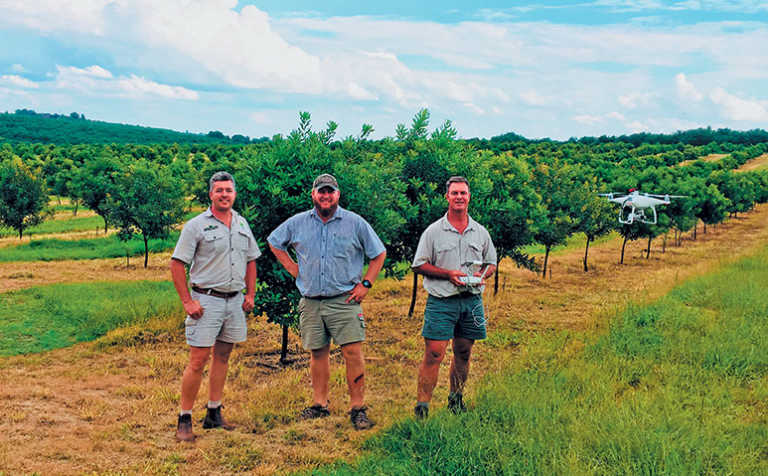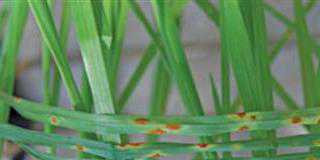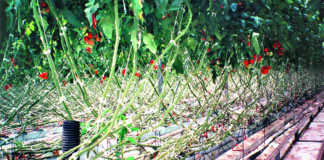
Photo: Supplied by Carbomax
For a farmer managing a macadamia orchard, certain things are non-negotiable. You need to know your exact tree count, you have to work your yields back to kilograms
of dry nut-in-shell yield per tree, and you need to ascertain where problems lie so that you can address them rapidly and effectively.
This is according to Martin Taljaard, founder of Carbomax, a company that uses drone technology to help macadamia farmers improve production.
READ Macadamia fertilisation: an expert guide for SA growers
Martin works with Jaco Prinsloo, a consultant at Loskop ICT, a fertiliser company based in Marble Hall, Limpopo, to pair drone technology with orchard-specific fertilisation and soil-specific moisture management, making production more precise than ever.
Martin’s involvement in this specialist field began through his work with Aerobotics, a Cape Town-based aerial data analytics company.
Aerobotics had developed software that uses infrared images from drones to assess whether trees are photosynthesising efficiently. To do this, it analyses reflections of chlorophyll, an indicator of photosynthesis.
Algorithms use the data to create a normalised difference vegetation index (NDVI), allowing users to identify unhealthy plants.
“Cameras fitted to a drone can identify problem areas. Using software combined with a mobile app, you can go to a specific spot in an orchard and determine the possible causes of problems,” explains Jaco.
Soil and leaf samples are taken to verify that there is a problem, and then to identify possible shortages or imbalances in a tree or an area.
A grid pattern based on coordinates
Martin begins by using Google Earth to compile a flight plan for a farm. He uploads the coordinates to a drone and pilots the drone according to specific grid-line patterns, mapping the pre-determined area.
The drone takes high-definition and multi-spectral images of an orchard with two separate cameras. After a mission, the images and data are processed by the software, and the farmer can log in to see the results. These can then be used to manage the orchard more effectively.
Other useful information, such as canopy volumes, tree heights, row spacing and tree size differences, are combined as part of a management programme. The technology does not only apply to trees, and can be used on other crops, as photosynthesis is key to all plant health and directly correlates with yield and profit/ha.
READ Smartphone apps – a clever weapon against intruders
“I advise farmers to over-fly their farms twice a year to determine progress and improvement from the recommended fertiliser and foliar feed programmes,” says Martin.
“In addition to established producers, we help those who’ve just bought a farm. For example, a farmer will tell us he bought a 24ha farm, but when we map it we find it’s actually 27ha. This makes a difference, as soil amelioration and fertiliser programmes are calculated per tree and per hectare.
“Incorrect application due to incorrect tree numbers or orchard size can increase input costs and decrease profit.”
Fertilising
When Martin encounters problem areas, he relies on Jaco to assist with recommendations for soil amendments.
Jaco insists that leaf samples be taken more frequently than the norm, so that requirements at various phenological stages are addressed and identified before shortages or deficiencies arise.
By asking for more detailed leaf and soil analyses from laboratories, the team can measure more accurately and determine soil and plant deficiencies accordingly.
“This allows us to react more proactively,” explains Jaco. “On receiving the analysis, I’ll suggest a certain fertiliser programme specifically formulated for the various orchards on the farm, taking into account the farmer’s management capabilities. We can suggest prescription mixed fertilisers per orchard, if needed.”
He adds that the requirements for particular nutrients change from one phenological stage to another, and a farmer needs to know the plants’ requirements before they arise, otherwise the orchards may experience nut drop, reducing yield.
“When a tree starts to flower, for example, it goes into stress and needs certain nutrients more than others to set the optimal amount of nuts,” he says.
Before pollination, then, a farmer needs to manipulate the trees with foliar sprays using a pre-determined combination of macro and micronutrients to enhance set.
“With this timely application, you get far more nuts and much less November nut drop from the trees on average,” Jaco explains.
To determine the effectiveness of his orchards, a macadamia farmer needs to know the yield of each tree.
“One kilogram more nuts per tree makes a massive difference, so you want to get optimal production from every tree,” says Jaco. “But if, say, 23% of your trees aren’t photosynthesising optimally, then you can’t determine the exact yield per tree.”
Healthy soil needs less fertiliser
Loskop ICT also seeks to enhance soil health and microbial activity. To this end, most of the company’s fertiliser is carbon-enriched.
“Carbon has several functions in the soil,” explains Jaco. “It feeds soil microbiology, helps stimulate new root growth and aids water infiltration of soils.”
After carbon-enriched fertiliser has been used for a few seasons, fertiliser use declines as the soil health improves.
The latter can be determined by a Solvita Soil Health test, which measures the microbial activity in the soils.
“We try to take harsh chemicals out of the process by replacing them with a more biological approach,” says Jaco.
“It’s a difficult concept 2018for some farmers to grasp, but when they see the results they’re sold on the concept.”
As an add-on to the drone, data from a satellite helps to determine the NDVI and soil moisture levels over time for certain areas and crops.
According to Jaco, many farmers over-irrigate. He therefore suggests installing capacitance soil moisture probes, supplied by Crop Systems, which take soil moisture content readings and sends them to a satellite every 20 minutes.
The probes are installed to a specific depth for each crop and indicate how many millimetres of water is available at certain depths.
Less irrigation and leaching
“If you manage irrigation precisely, fertiliser is also absorbed more effectively and you have less leaching of nutrients,” explains Jaco.
“One of the farmers we helped is now using 60% less water on his farm. He was over-irrigating and didn’t realise it as his soils were well drained.”
When using Crop Systems’ probes, Martin initally takes a soil sample and sends it to a laboratory to determine the soil’s water-holding capacity. Minimum and maximum water-holding capacity levels are then set individually.
The software places orchards that need irrigation at the top of the list when the app is opened, so the user’s attention is drawn to them.
This is combined with moisture levels and NDVI readings on one platform. A user can also access specific trees and photographs taken at certain times with GPS locations.
Phone Martin Taljaard on 082 884 0866, or email him at [email protected].
Phone Jaco Prinsloo on 082 477 2670, or email him at [email protected].











